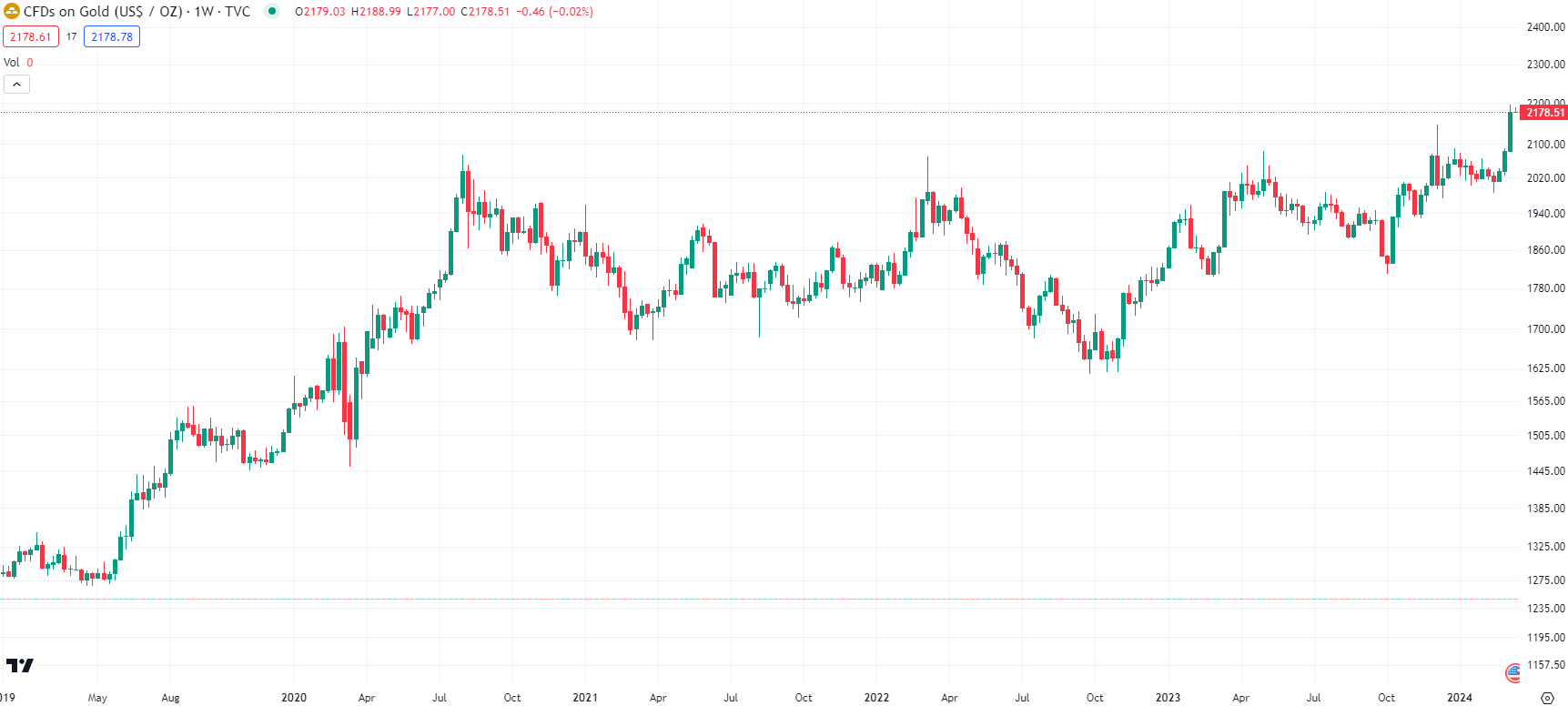Where will gold prices go after surpassing US$2,000/oz? And which ASX gold stock looks good right now?
Nick Spencer, March 13, 2024
Where will gold prices go? It is a question investors are asking all the time, but particularly in recent years given that global geopolitical instability and macroeconomic turbulence are its two best mates. But where to now from here? Will investors buying gold end up buying high and selling low, or will they still reap some growth?
It is good to be in gold
The precious metal had a ball in 2020 as the COVID-19 pandemic widely proliferated across the globe, reaching a high in August 2020 surpassing $2,000 USD per troy ounce for the first time. As conditions normalised, interest rates remained low and inflation moderated…the rally didn’t last.
However, the gold price reached another high of $1,998.10 USD per troy ounce on 7 March 2022 as a result of Vladimir Putin’s incursion into Ukraine and as investors swiftly responded to the supply bottlenecks and sanctions that were subsequently factored into markets.
Fast forward yet another two years and gold is riding another rally as a multitude of international financial headwinds prove themselves to be far from transient.

Source: WallStBets/Reddit
On Friday March 7, 2024 gold reached a new all-time high of $2,195 USD per troy ounce with demand quickly ramping up as major economies battle a number of severe unprecedented burdens. And with the current exchange rates, gold is over A$3,000/oz.

Gold price, log scale (Source: TradingView)
Inflation hedge?
Gold has for centuries been viewed as an inflation hedge because of its extremely low price volatility as a by-product of limited global supply. This gives the price of gold an innately inverse relationship with the value of fiat currencies. After all, there was a reason the shiny metal has historically been used as a standardised means of exchange either directly or indirectly when the gold standard was still in place.
The period in which gold prices experienced the most volatility was in the late 1970s and early 1980s when market uncertainty pushed immense upward pressure on the commodity until January 1980, when that demand quickly faltered.
Even still, it only declined 50% in two years, which is far more benign than the extreme fluctuations of most market-based assets.
So, where will gold prices go from here?
If you fundamentally look at the upward trend of the gold price as contingent on pretty dire global circumstances, the future outlook can be rendered soberingly clear.
Although the current narrative purported by most Western economists is that the US economy looks almost certain to avoid a recession and hit a soft landing, most data reveals that American demand for gold doesn’t account for very much of the recent rally.
In terms of impact on the price of gold, the fact that the US economy is performing well in getting back on its feet relative to many other countries may be entirely offset by the imminence of interest rate cuts in America.
Federal Reserve Chair Jerome Powell said last week that it would likely be appropriate to reduce borrowing costs at some point in 2024, although exactly when is unclear. He did however, maintain that the Fed would only consider such an option if inflation was on target to move sustainably to 2%.
The prospect of lower rates is extremely good for gold prices given it curtails the opportunity cost of holding and buying gold by reducing demand for bonds.
China contributing to the demand
Regardless, most of the recent demand for gold seems to be coming from China, where troubles are heating up to profound magnitudes. The Middle Kingdom seems to be bordering on a financial crisis unseen since its rapid economic uplift at the turn of the century, with most analysts pointing to a particularly turbulent construction sector remaining conducive to a continued overall downturn.
Real estate is the preferred means of investment for the Chinese, with property-related industries contributing to around 30% of national growth. As such, the Hang Seng Index — comprising 82 stocks listed on the HKSE — is down 18% over the past year. China’s most senior economists and bureaucrats are taking appropriate steps to mitigate this downturn, a major one being a rampant upswing in gold purchases.
The People’s Bank of China recently added gold to its reserves for a 16th consecutive month, now owning 72.58 million troy ounces of the precious metal, equivalent to around 2,257 tonnes.
We remain bullish on gold
It’s not just Chinese public investment in gold either. Swiss exports to China — a barometer widely used by commodity analysts to gauge demand for gold — doubled in January from December to 77.8 tonnes. Shipments to Hong Kong rose almost sevenfold to 44.6 tonnes. In fact, according to UBS, around half of all gold shipments in January went to Hong Kong and Mainland China.
It’s not as if all of this demand is departing the globe anytime soon either. If there’s anything that these last few years have shown the world, it’s that we still have a long way to go in terms of deleveraging and correcting the markets from over a decade of monetary stimulus that we seem to have forgotten isn’t free.
Not to mention that QE is only one side of the story when it comes to the bona fide drivers of current inflationary levels that are deemed by many to be well out of reach of the relatively blunt tools at the disposal of central banks.
So yes, in our view, it doesn’t seem as if gold prices will be experiencing any downward trends anytime soon.
What does all this mean for gold miners and explorers?
With gold prices rallying, it is a good time to be an ASX gold miner or explorer. It is true that listed stocks are not the only way to invest in gold, although it is arguably the easiest.
It is inevitable that the biggest of miners will have assets good enough to withstand all but the lowest of gold prices – otherwise, they wouldn’t have been bought into production. Take for instance the Acadia mine in NSW (now belonging to Newmont after it snapped up Newcrest). Acadia has seen some ups and downs in its 30+ years of operation. But for explorers wanting to become the next big miner, high prices will give them confidence to explore, they will find it easier to raise money from investors and ride market sentiment.
Of course, this does not mean a company can get away with not having a quality asset. Neither does it mean that companies with quality assets won’t be able to find the money to develop them – just ask Gold Road that developed its project in the first half of the 2010s when gold was weaker than now. Nonetheless, gold stocks will have it easier.
Our favourite gold stocks
Our favourite gold stock right now is De Grey Mining (ASX:DEG) that is seeking to bring the 10Moz+ Hemi deposit in WA’s Pilbara into production within the next 3 years. Hemi could produce 5.7Moz over 12 years, equating to over 500,000 ounces per annum. It would deliver $4.5bn in free cash flow after tax, a payback of less than 2 years despite a capital cost of nearly $1.3bn. The DFS showed an NPV of $2.9bn post-tax, representing an IRR of 36% at an AISC of $1,295/oz over the first 10 years.
Another one we liked is Red 5 (ASX:RED), a stock set to be promoted into the ASX 200 next week as of the time this article was written. This stock has two operating mines in WA and just delivered a >70% jump in sales revenue, gold sales and production. It may be promoted further if the proposed merger with Silver Lake (ASX:SLR) goes ahead.
Watch gold prices
Even if you don’t want to invest in gold, we recommend all investors keep an eye on gold prices, because they are a good gauge of economic sentiment. In our view, there’s still some more room left for gold prices to rally in the rest of 2024.
What are the Best ASX Gold Stocks to invest in right now?
Check our buy/sell tips
Blog Categories
Get Our Top 5 ASX Stocks for FY25
Recent Posts
Here’s why Rich Lister WiseTech boss Richard White ‘stood down’, and how the A$30bn+ cargo software giant may be affected
WiseTech boss Richard White has been viewed as a key reason for his company’s success over its 30-year history and…
Is the S&P 500 Really Doomed to a ‘Lost Decade’? Goldman Sachs thinks so, but will it eventuate?
The term ‘Lost Decade’ gets thrown about a lot, but most recently to the next decade to the S&P 500.…
Halloween Stocks: Here are 5 ASX Stocks that Will Benefit from Halloween
Here are 5 ASX Halloween Stocks! The Reject Shop (ASX:TRS) The Reject Shop is one of Australia’s most notable…



